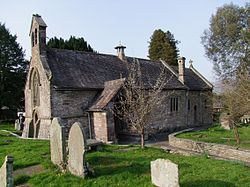Llanfoist
| Llanfoist | |
| Monmouthshire | |
|---|---|
 St Faith's Church, Llanfoist | |
| Location | |
| Grid reference: | SO2861213049 |
| Location: | 51°48’40"N, 3°2’8"W |
| Data | |
| Post town: | Abergavenny |
| Postcode: | NP7 |
| Dialling code: | 01873 |
| Local Government | |
| Council: | Monmouthshire |
| Parliamentary constituency: |
Monmouth |
Llanfoist is a village, near Abergavenny, in Monmouthshire. The name of the village derives from St. Fwyst, an early Christian saint, although the anglicised name of the church patron is St Faith.
History
The Church of St Faith
1901 Kelly's Directory of Monmouthshire describes the parish church of St Faith's:
"".. an ancient building of small dimensions, in the Gothic style, consisting of chancel, nave, south porch and a western bell gable with two bells" adding "The windows are stained; one on the south side, of three lights, was placed by Mrs. Wheeley in memory of her father. The east window and two small ones in the chancel were erected by the neighbouring gentry to the memory of Crawshay Bailey esq., the great ironmaster of Nant-y-glo, who is buried here. A three-light window on the north side was given by his tenantry as a memorial to the same. The chancel was restored in 1877 by Crawshay Bailey esq., son of the above, and since, deceased. There are 80 sittings. In the churchyard are two ancient yew trees, and an ancient stone cross."
The church holds records for baptisms from 1736–1975, for marriages from 1736–1971, for banns from 1824–47 and 1890–1933, and for burials from 1736-1945. There are also Bishops Transcripts for 1725-32, 1734–51, 1753-4, 1756–75, 1777–1806, 1808–10, 1813, 1815–16, 1820–37, 1841–58, 1862–1865, 1869 and 1880.
The village also had a Wesleyan Methodist Chapel, erected in 1839. In 1851 the attendance was 200 for morning worhsip (with 180 scholars), 200 scholars in the afternoon and 40 for evening worhsip with 50 scholars.[1]
Crawshay Bailey and Alexander Cordell
Llanfoist was home to the famed, or infamous, ironmaster, Crawshay Bailey. Before 1851 he had retired to Llanfoist House in the village. A local park in Abergavenny is named Bailey Park in his honour and Llanfoist Primary School had a house named after him until 2008 when the House was renamed 'Skirrid'. He died in 1872, aged 83, after at least seventy years in industry. His only son and heir, Crawshay Bailey II (born 1821), inherited his estate.
The novelist Alexander Cordell, most famously author of Rape of the Fair Country is buried at Llanfoist.[2]
Amenities and Attractions
The village is located beneath the hill known as Blorenge, part of the Brecon Beacons National Park, rising 1,838 ft above sea level over the vale of the River Usk. The hill can be ascended on foot from Llanfoist, straight up its 'front', a very direct route but also very steep. The rewarding views from the top are among the best in South Wales.
The Monmouthshire and Brecon Canal [1] runs just above the village offering an excellent flat route for contour walking along the valley side, with views across to the Black Mountains. Llanfoist Wharf [2], at a very picturesque location, a quarter of the way up the Blorenge, is now owned by a narrowboat hire company.
The village has a church hall, situated on the Merthyr Road, which holds Public Liability Insurance.[3]
On 2 January 2012 an ancient yew tree in the grounds of St Faith's Church, which was believed to be up to 1,000 years old, was brought down by high winds.[4]
References
- ↑ Jones. I. G., and Williams, D., (1976) The Religious census of 1851: A Calendar of the returns relating to Wales, Vol 1, South Wales. UWP, Cardiff.
- ↑ "In the footsteps of Alexander Cordell in South Wales" at literaturewales.org
- ↑ "Llanfoist St Faiths Church Hall" at monmouthshire-halls.org.uk
- ↑ "'1,000 year-old' Llanfoist tree felled by gales", by Kath Skellon at southwalesargus.co.uk
| ("Wikimedia Commons" has material about Llanfoist) |